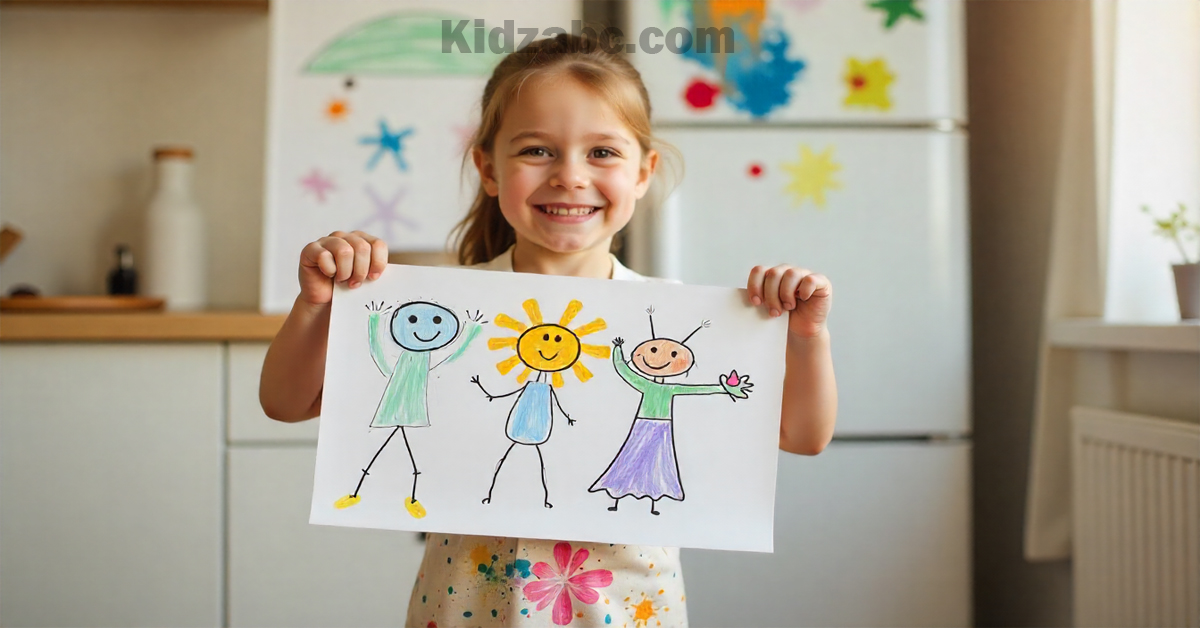Encourage Drawing Skills, Confidence, and Creativity in Young Children please ensure those things. Drawing is more than just a fun pastime for children — it’s an essential part of their development. Whether your child is doodling with crayons or painting with watercolors, they are engaging in a powerful creative process that helps build fine motor skills, emotional intelligence, confidence, and self-expression.
In this blog post, you will discover proven ways to support your child’s artistic journey — even if you’re not an artist yourself. We’ll explore practical, child-friendly methods to nurture drawing skills, build creative confidence, and inspire imagination in everyday life.

From setting up a supportive drawing environment to using open-ended art prompts, we’ll break down the best techniques for parents, caregivers, and educators to guide children’s creativity at home or in school. You’ll also find a detailed FAQ section that addresses common questions about children’s art development, frustration with drawing, and how to balance structure with freedom.
This comprehensive guide is perfect for parents of toddlers to pre-teens and includes image suggestions you can use on your blog to illustrate each section. Whether your child is a budding artist or just starting out with scribbles, this post will equip you with everything you need to spark joy and confidence in their artistic abilities.
1. Don’t Ever Denigrate Yourself or Your Own Drawing Abilities
Children model what they see. If you say, “I can’t draw,” they may feel discouraged from trying themselves. Show confidence in your creativity—it empowers them to do the same.

2. Be Conscious of How You Talk to Your Child About the Art He or She Makes
Avoid judgmental or overly critical comments. Focus on curiosity—ask open-ended questions like “What’s happening in your picture?” to encourage storytelling and pride.

3. Make Art Fun and Exploratory With Encourage Drawing Skills
Art is meant to be joyful and open-ended. Let your child experiment without rules or expectations. Exploration fuels creativity more than perfection ever can.

4. Keep Art Activities Developmentally and Age Appropriate With Encourage Drawing Skills
Offer drawing tools and activities that match your child’s age and motor skills. This ensures they feel successful and stay engaged in the creative process.

5. Reasons To Try Other Art Classes
Art classes can expose children to new techniques, media, and artistic perspectives. They’re great for social learning, motivation, and building lifelong creative skills.

6. Reasons To Try Art Classes For Adults
When adults engage in art, they become better mentors for children. Taking art classes yourself models lifelong learning and helps you rediscover your own creativity.

7. Drawing Prompts and Jean’s Book!
Creative drawing prompts can kickstart your child’s imagination. Jean’s book, full of engaging ideas, is a great resource for inspiring kids to draw with confidence and joy.

🎨 Why Drawing Matters in Early Childhood
Drawing supports:
- Fine motor skills (grasp, control)
- Visual thinking
- Problem-solving
- Communication
- Self-confidence
Studies show children who draw regularly are better at expressing feelings and understanding visual information.

🏡 The Role of Environment in Drawing Development
Children thrive in an environment that welcomes mess, freedom, and creativity. Here’s how to design a drawing-friendly space:
- Keep materials accessible
- Display their artwork
- Create a no-judgment zone
- Offer space, not perfection

🖍️ Tools and Materials That Inspire Creativity
Children don’t need expensive materials. A mix of simple and exploratory tools is best:
- Crayons, pencils, markers
- Watercolor paints
- Large paper, recycled paper
- Chalk, oil pastels
- Textures (bubble wrap, sponges)

✨ Encouraging Confidence Through Process Art
Process art means focusing on the act of creating, not the final result. It helps children:
- Take creative risks
- Feel proud regardless of the outcome
- Develop their own ideas
Say things like:
“I love how you filled the page!”
“Tell me about what you made.”

⚠️ How to Avoid Common Pitfalls with Encourage Drawing Skills
Avoid saying:
- “What is that supposed to be?”
- “Stay inside the lines.”
- “That doesn’t look right.”
These can make children self-conscious. Instead:
- Ask open-ended questions
- Praise effort, not outcome
- Allow experimentation
💡 Using Prompts to Spark Imagination with Encourage Drawing Skills
Creative prompts boost curiosity. Try:
- “Draw an animal that doesn’t exist”
- “What would a flying house look like?”
- “Design your own superhero”
These prompts encourage storytelling and originality.
🧒 Drawing Activities for Different Ages
Toddlers (1–3 years):
- Scribbling with crayons
- Finger painting
Preschoolers (3–5 years):
- Drawing people, animals
- Using shapes to build scenes
Early School Age (6–9 years):
- Story drawing
- Comics, captions, characters
Tweens (10–12 years):
- Realistic sketches
- Shading, detail, emotions
👨👩👧 The Role of Parents and Teachers
Adults should act as guides, not directors. Instead of correcting, encourage:
- Questions and imagination
- Self-reflection (“What do you like about this?”)
- Displaying artwork proudly
📏 Creative Freedom vs. Structured Lessons
Balance is key:
- Too much freedom? A child may feel lost.
- Too much structure? Creativity may be stifled.
Tips:
- Offer light guidance (“Try drawing with only one color today!”)
- Let the child decide the subject.
💖 Emotional Benefits of Drawing
Drawing provides emotional release and supports:
- Stress relief
- Self-regulation
- Identity building
- Problem-solving through storytelling
📱 Technology and Digital Drawing
Digital drawing tools like tablets can:
- Offer new textures and effects
- Allow “undo” for experimentation
- Teach tech-based creativity
Balance screen time with hands-on art.

❓ Frequently Asked Questions (FAQ)
Q1: What if my child says “I can’t draw”?
Encourage them by saying, “Everyone learns by practicing” or “Just draw how you feel—it doesn’t need to be perfect.”
Q2: How often should children draw?
Ideally, daily or at least 2–3 times per week. Even 10-minute sessions make a difference.
Q3: My child gets frustrated while drawing. What should I do?
Step in with empathy. Offer a break, remind them it’s okay to make mistakes, or try a new prompt to shift focus.
Q4: Should I enroll my child in art classes?
Optional. If your child shows interest, a supportive class can help. But home drawing is just as valuable.
Every child is born with creative potential. Drawing is a magical tool to nurture imagination, confidence, and communication. As parents and educators, we can offer the space, encouragement, and materials needed for that creativity to flourish — without pressure or perfection.

Let them scribble, explore, and express — the results might just surprise you.



